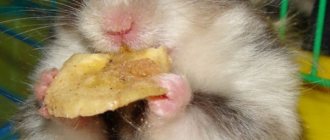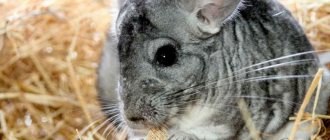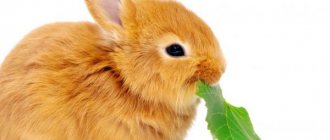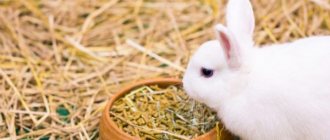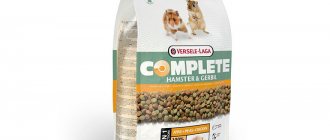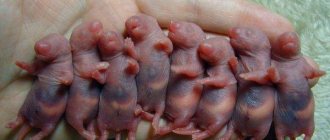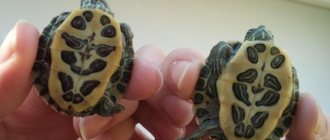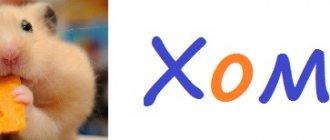- home
- Nutrition
19.03.2018
Having decided to purchase a hamster, inexperienced owners are faced with a number of questions. First of all, you need to find out how many times a day to feed your hamster. Despite the apparent obviousness of the answer, difficulties may arise. The smaller the animal, the more careful treatment it will require.
It is very important to feed your Djungarian hamster properly. After all, healthy nutrition and digestion are the key to the long life of this small animal, which is why it is important to take into account the feeding regime.
How many times a day should you feed your hamster?
Nutrition and diet are of particular importance for the healthy existence of a hamster.
Feeding frequency
Due to the increased activity of these pets at night, two main feeding options are preferable:
- once - late in the evening;
- twice - in the evening and early in the morning.
In this case, the main volume of food should be consumed in the evening feeding.
If the owner determines for himself a comfortable time for feeding the animal and sticks to it, then the rodent will always wait for the food it is supposed to eat at exactly this time. And such stability in the timing of food supply has a positive effect on the animal’s digestive processes.
IMPORTANT . For these small rodents, hunger strike is unbearable, so access to food must be available around the clock.
Also, due to their accelerated metabolism, these pets can wake up several times during the day to have a snack..
The breeder is also recommended to:
- Do not overfeed the animal - feeding twice a day is most optimal.
- Do not disturb the rodent's sleep by constantly feeding it throughout the day.
- Regularly audit inventory, removing spoiled products.
Amount of food
The owner must determine the amount of food for the animal, taking into account the following points:
- what is his physical activity;
- what age is the animal, since young animals need more food ;
- what is his physiological state - painful condition, pregnancy or lactation period;
- what are the environmental conditions – room temperature.
ATTENTION. According to statistical data, rodents of this kind consume an amount of food per day equal to about 70% of their body weight. Those. if, for example, a Syrian hamster weighs 150 g, then per day he will eat about 100 g of food.
The breeder does not have to resort to such precise mathematical calculations. It is enough to observe the animal for several days to determine how much food it needs. It is important not to overdo it with the amount of food, otherwise the hamster will quickly gain weight . This will have an impact on his health and life expectancy.
Amount of food
How much a hamster eats per day depends on several factors:
According to statistics, a hamster eats a volume of food per day equal to 70% of its body weight. For example, a Syrian weighing about 150 g should be fed 100 g of food.
As a rule, owners do not make accurate calculations, guided by observations of the pet. Don't feed your Djungarian hamster too much. Overfeeding will lead to obesity and health problems.
It’s funny to look at a fluffy, plump dwarf, but the animal is very uncomfortable with excess weight. Obesity threatens serious diseases and shortens the life of a hamster. Keep an eye on your pet while eating; he may not eat the amount of food intended for him, but may hide some of it.
Nutrition for small hamsters
In cases where a hamster gives birth to babies or very small hamsters were purchased, the owner has the question of how and what to feed such babies.
If hamsters live with their mother, then she feeds them for up to 1-1.5 months. However, if the female refuses to feed the babies or for some reason cannot do so, then the owner will have to feed the hamsters.
- First week. Newborns are fed regular infant formula via a syringe (without a needle) or dropper every three hours a day and twice at night.
- Second or third weeks. Hamsters can gradually add finely grated vegetables, fruits and food, as well as boiled porridge . In this case, you should gradually reduce the amount of infant formula.
- Fourth week. From this point on, small rodents are already able to feed on their own without any restrictions in the diet, so you can finish feeding with infant formula .
Have you ever had to supplement feeding newborn rodents?
When should you feed your pet meat?
As a rule, hamsters spend whole days sleeping and wake up around eight o'clock in the evening, so they need to develop an evening diet. You can feed them only once in the evening, and twice in the morning, then feed them with meat, which should only be fresh and good quality, like other food. The owner of the animal must monitor the pet’s sleep and wakefulness patterns and feed it on time and at the same time appropriate for it. The type of feed required is also the same. Early in the morning, for example, around seven o'clock, you can offer your pet hearty boiled vegetables, succulent food, herbs and protein foods.
The source of protein will be meat and fish, which should be boiled and without salt. A small piece of lard will do for a hamster. Healthy food for a hamster will be chicken meat, boiled liver and beef heart. Thanks to vitamin A contained in the liver, the pet's coat improves. The second feeding is in the evening and involves a grain mixture or porridge, and hamsters do not like to go without treats. Hamsters can eat small amounts of meat-based dog and cat food.
Meat products are also recommended for females who are about to give birth to offspring. They are very healthy, along with hard-boiled eggs.
Read more about hamster nutrition here.
Nutrition for elderly and sick hamsters
Animals that are sick or are already quite old (elderly) are characterized by a decrease in their activity and appetite. Therefore, the owner needs to rebuild the animal’s diet and feeding regime.
- Food should be predominantly chopped and grated. also give porridge with water or pureed vegetables without salt and sugar with added vitamins.
- To prevent intestinal disorders, your pet must be given grain food.
ATTENTION. The animal should be provided with plenty of fluids to prevent dehydration. As a drink, you can prepare a chamomile decoction or regular drinking water, but exclude honey and milk
Peculiar look
At first glance, it is clear that this is not the forest fluffy beauty that we are used to seeing in pictures. But they resemble them in the shape of their head and curved back. The Chilean degu squirrel is usually gray or brown, but these animals can also be red. On the back the hair is longer and coarser. The abdomen is usually lighter - from cream to milky in color.
The main difference from an ordinary squirrel is that this animal does not have a luxurious tail. In degus it is covered with skin, which, with a sharp tug, is removed with a stocking. After this, new skin grows on the base. Adult individuals weigh 300-400 g. Their length is approximately 40 cm including the tail. Domestic pets usually weigh and grow slightly less than their wild counterparts.
The digestion of these animals is quite sensitive, so you need to consult with the breeder and choose the food for degu that he recommends. We'll talk about this in more detail below. The squirrel's vision is not very sharp, but the eyes are located in such a way that they can provide a wide range of vision. The animal has excellent hearing and sense of smell, so it quickly and easily navigates. Moreover, regardless of the time of day and lighting. The animals live quite a long time. In nature, this period is limited to 6-8 years, and at home they often live up to 12 years.
Nutrition of Djungarian hamsters
This variety of domestic rodents, such as Djungarian hamsters, has become very popular among breeders because they are not only attractive in appearance, but also unpretentious. However, breeders should also know the peculiarities of feeding such animals.
- The basis of the diet of this rodent, like others, is dry food. It is recommended to purchase several different ready-made mixtures at a pet store to balance the supply of all necessary minerals and vitamins.
- Preference should be given to cereals such as buckwheat (raw and cooked), wheat (especially sprouted), oats or oat flakes, barley, pearl barley, lentils, peas, chickpeas. Minimize rice and millet in your diet.
- Raw or oven-dried sunflower seeds without salt.
- You can give milk or cheese to animals, but not more than once a week, and choose high-quality products with a minimum fat content.
- Food rich in protein is also necessary for Djungarians, and the meat should be of a lean variety (beef, chicken) . Meat and offal should be boiled without salt and spices. You can also give your pet 1/3-1/2 of a boiled egg.
- It is better to exclude fresh bread, but a small cracker once a week is allowed.
- to pamper your hamster with nuts, berries, fruits (exclude exotic ones and remove the seeds) and dried fruits , but do not overfeed them in small quantities, since a large amount of sugar in fruits can cause diabetes.
- Vegetables should also be present in the animal’s diet - cucumbers, radishes, bell peppers, cabbage, carrots, zucchini and others. It is also recommended to give various greens, such as parsley, dill, lettuce or spinach.
REFERENCE. Rodents love to chew on tree branches, and these should be young branches of fruit crops. Coniferous species are excluded, since their resin is dangerous to the health of animals.
Djungarian hamsters will only need two main meals - in the evening and early in the morning. At the same time, food must be present in the cage around the clock - it is necessary for daytime snacks.
Common feeding mistakes
To avoid health problems, you need to feed your hamster properly. Often, inexperienced owners violate nutritional rules and put their pet at risk:
- Eating too often. This leads to weight gain. Obesity causes digestive disorders, blockage of blood vessels, cardiac arrest and various dangerous diseases. That is, excess weight shortens the already short life span of rodents.
- Large portions of food. This will also lead to weight gain and the development of many diseases.
- Insufficient or irrational nutrition. A hunger strike is dangerous for a rodent, as its body suffers from a lack of nutrients, which increases the risk of various diseases. It is important to provide the animal with high-quality dry food, and to use vegetables, herbs, fruits, and protein foods for feeding.
- Feeding your pet stale or spoiled food. It is necessary to regularly remove spoiled food from the feeder. If a hamster eats spoiled or moldy food, it risks poisoning and other digestive disorders.
- Introduction of forbidden foods into the diet. You should not feed your hamster fatty, starchy, or too sweet foods.
- Irregular cleaning of the feeder. You should feed your hamster only from clean dishes. After the meal, you need to remove any leftover food and wash the container.
Feeding your hamster correctly means creating a diet of healthy and varied foods, following a meal schedule and controlling food portions. The set of rules is supplemented by regular cleaning of the cage after eating and washing the feeder. In this case, the pet will be healthy and active.
Inventing entertainment
Of course, the hamster always has a lot to do in his cage, but sometimes he needs some extra entertainment. You can buy him toys or make him a real amusement park that you can use while walking.
Prepare:
- several toilet paper tubes and paper towels;
- empty plastic bottles;
- empty cardboard boxes of different sizes;
- cardboard;
- cardboard scissors or linoleum knife.
How to build an amusement park?
First, think about what it will look like. Lay out all the materials on the floor or make a sketch. Now start assembling.
Make a slit in the center of one of the pipes. Connect some of the pipes to each other, and insert some into boxes. Cut round holes in the top of some of the tubes. They are needed so that the hamster can stick out of the holes. Close the system of pipes and boxes to each other.
Make sure that there is enough space in the pipes for the animal - otherwise it will not fit there.
Don't forget about safety!
- Look for boxes that are missing writing or graphics. The animal will probably gnaw on them, and the paint may give you a stomach ache.
- Do not use glue or tape. They can stain fur and are very dangerous if ingested.
- If you don't want to bother with cardboard, assemble the entire structure from plastic. Sections of sewer pipes are excellent for this purpose. They are easy to attach to each other. Show your imagination, and your pet will definitely thank you.
For the convenience of walking your hamster outside, you can purchase a hamster leash.
What should you not give?
Animals will eat almost everything you offer them; they do not know the dangers of many foods for their stomachs. But the owner should know exactly which products are prohibited, and accordingly protect his pet from them:
- Any sausage products.
- Milk and dairy products.
- Fatty meat, lard.
- Mushrooms.
- Onion garlic.
- Honey.
- Sweets, chocolate, cookies.
- Berry seeds.
- Canned food.
- Fresh bakery.
- Pasta.
- Salt, sugar, spices.
- Various fats.
- Exotic fruits.
- Fried, fatty, spicy food.
An incorrect diet will contribute to the development of obesity, allergic reactions and digestive problems. In advanced cases, the animal simply dies.
Providing your hamster with proper nutrition is not difficult at all. The main thing is to exclude prohibited foods from his diet and make the food as varied as possible. Good nutrition will give your pet excellent health and enable it to live as long as possible.
Natural food for rodents
The food of rodents in natural conditions directly depends on the animal’s habitat. In the wild, hamsters prefer to live in fields, so grain crops are their main food. If people live near the habitat of the animals, then the animals will definitely visit the village. There they sniff out places where vegetables and fruits are stored or find food in vegetable gardens and orchards. They do not disdain strawberries, cucumbers, grapes, apples and other fruits grown by people.
In spring and summer, part of the daily diet of wild hamsters consists of greens. “Fuzzies” eat grass and leaves with appetite. If there are spiders, worms, caterpillars, or beetles on the way, they do not disdain such food.
Hamsters only seem so kind in appearance, but in order to survive in the wild they can be bloodthirsty. If a wounded, helpless animal comes across, the hamster will not disdain fresh meat.
